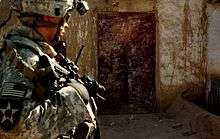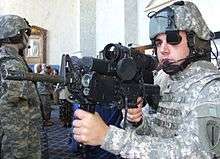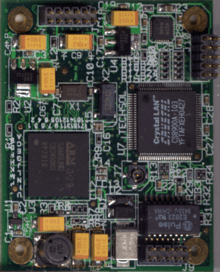Land Warrior
Land Warrior was a United States Army program, cancelled in 2007[1][2] but restarted in 2008,[3] that used a combination of commercial, off-the-shelf technology (COTS) and current-issue military gear and equipment designed to:
- integrate small arms with high-tech equipment;
- provide communications and command and control at the infantry soldier level;
- look at the individual infantry soldier as a complete unit rather than as a segment of a larger force.

While technology had long been a primary focus of the U.S. Armed Forces, very little of it had actually been adopted by the U.S. Army infantry soldier. With growing concerns of urban warfare and dismounted infantry actions, the U.S. Army recognized the need to upgrade an individual infantryman. The Land Warrior program drew upon many wearable computer concepts, and maximized existing technologies to correct most infantry soldier limitations in the short term.
The SI (Stryker Interoperable) version of the system completed U.S. Army testing as of November 2004. Due to limited resources, and issues with the overall weight of the system, Land Warrior was cancelled by the Army in February 2007, but restarted in July 2007. Despite the initial system's cancellation the 4th Stryker Brigade Combat Team (SBCT) was deployed to Iraq as part of the spring 2007 "surge" of U.S. forces, and used the Land Warrior, on which they had trained for the previous few years.[4]
The systems and technology of the Land Warrior program were to be rolled into the Future Force Warrior program, and the Army has developed the Nett Warrior system to supersede Land Warrior as its next soldier network program.
Internationally, there are several similar development programs, these include IdZ (Germany), FIST (UK), Félin (France), Land 125 (Australia), MARKUS (Sweden), Soldato Futuro (Italy), IMESS (Switzerland), Projekt TYTAN (Poland), FINSAS (India) and ACMS (Singapore), Ratnik (Russia), SARV (Iran).
History
The original Land Warrior program, by other name, was undertaken by General Electric in Moorestown, New Jersey approximately 1989, as a prototype having intent to eventually reduce size and weight in future phases. Then in the mid-1990s, the name Land Warrior was initially handled by a division of Hughes Aerospace, which was subsequently acquired by Raytheon. (The soldier radio component of Land Warrior was to be supplied by the Integrated Information Systems division of Motorola.[5])
Early demonstration versions of the LW system used software written in the Ada programming language running on a Unix platform. In January 1999, in an attempt to reduce development costs and accelerate the program, the development work was transitioned to a multi-company team that had been organized by Exponent (NASDAQ: EXPO), an engineering firm with headquarters in Silicon Valley.
An intensive redesign of the system ensued, and both the embedded firmware and the application software were rewritten from scratch. Many of the COTS hardware components were purchased (literally "off the shelf") at Fry's Electronics, the Silicon Valley retail chain. Approximately 100 proof-of-concept Land Warrior units were built and successfully demonstrated in September 2000 by a U.S. Army platoon that was air-dropped into a large war-fighting exercise at Fort Polk, Louisiana.
These initial prototype units, designated Land Warrior v0.6, were built around a PC/104 computer platform running Microsoft Windows. The system used the CAN-bus protocol on the wired PAN (personal area network). The communications subsystem was built using Windows CE running on a StrongARM platform, and the wireless network protocol was IEEE 802.11. During the Fort Polk exercise, preliminary interoperability with traditional military radio networks was also demonstrated for LW v0.6, using a two-way, SINCGARS-compatible gateway radio.
The success of the Fort Polk exercise reinvigorated the program, and further funding was allocated for the next phase of LW development. A "Land Warrior Consortium" was formed by several of the contracting firms, with the goal of designing and building the first field-able LW system, designated LW v1.0, later LW-IC (Land Warrior – Initial Capability). The basic Windows and WinCE platforms were retained, and a new hybrid PAN was designed, which drew upon both USB and FireWire protocols. A modified version of the IEEE 802.11 protocol was adopted, which added various enhancements for COMSEC and information security, mobile ad hoc network (MANET) capabilities, and support for multi-hop packet routing.
In 2003, a variant of the LW-IC system was developed to incorporate features of the CombatID System (CIDS) – a form of IFF (identification friend or foe) that is designed to reduce the potential for friendly fire incidents. This version, designated LW-CIDS, was successfully demonstrated in interoperational tests with several other CIDS-equipped units at Moffett Field, California.

As the Land Warrior program matured, it became clear that its successful deployment would hinge significantly upon the key factor of batteries. The need to continuously resupply (or recharge) LW batteries was proving to be a major logistical challenge. This was one of the driving factors behind the decision to move away from an earlier plan to initially equip airborne Army units, as in the Fort Polk exercise, and to focus instead upon those using Stryker ground vehicle systems. This latter approach would enable more LW batteries to be distributed and/or recharged as needed.
The contract for development of the Land Warrior – Stryker Interoperable (LW-SI) version of the system was awarded in 2003 to an industry team that was led by General Dynamics[5] and included most of the existing Land Warrior Consortium companies. At about the same time, further development of the existing LW-IC system was halted and the manufacturing plans for it were shelved indefinitely. The Land Warrior Consortium was formally disbanded and work got under way on the newly focused LW-SI program.
In September 2006, the 4th Battalion, 9th Infantry Regiment trained with and evaluated the LW-SI system.[6][7] The system successfully completed the assessment, which was based on Joint Capabilities Integration and Development System (JCIDS) guidance, and received testimonials from the unit. However, funding for further system development under the Land Warrior program was suspended in February 2007, although the 4–9 Infantry was deployed to Iraq and used the LW-SI system extensively. The Land Warrior program was then re-instated.[3] This was the final trial phase before the key decision is made on the overall future of wearable soldier systems, including Future Force Warrior. The decision was made in 2011 to continue the program.[1][2][4]
Description
Land Warrior has three priority objectives:
- Improving the lethality of an individual soldier
- Increasing the survivability of a soldier
- Providing full command, communications, and control to a soldier
Land Warrior has seven main subsystems:
- Weapon
- Integrated helmet assembly
- Protective clothing and equipment
- Computer
- Navigation
- Radio
- Software system
Later features of the Land Warrior system included:
- providing dismounted soldier combat identification for en route situational awareness and power recharge to reduce 'friendly fire' incidents
- Commander's Digital Assistant leader planning tool
- weight and power reduction
- scalability and tailorability for operational missions
Weapon

The original system was built around the M16 rifle or M4 carbine, both with modular rail mounts to allow customization as needed for each mission. It included the weapon itself, plus components such as a daylight video sight, thermal weapons sight and MFL (Multi-Function Laser). The MFL provided range and direction information, as well as IR, visible, and MILES lasers, while the cameras provided a video feed and thermographic capabilities, plus allowing a soldier to shoot around corners or behind cover without actually exposing himself to enemy fire. This is highly effective for confirming kills without exposing one's position.
Helmet
The Helmet Subsystem (HSS) combined a lightweight advanced helmet with a computer and OLED display that provided various information from digital maps and troop locations down to his weapon-mounted video camera. This is what would have allowed the soldier to see (and fire) around corners. The HSS also incorporated a microphone as well as a headset.
Armor and protection
The Interceptor Body Armor system and Modular Lightweight Load-carrying Equipment (MOLLE) load-bearing system currently in service with the U.S. Army today are partially a result of the Land Warrior program.
Computer
The Computer Subsystem (CSS) provided the processing power and storage capacity for the system. The CSS is based around an ARM core processor. Prior to the project's cancellation (when project funds were moved to Hurricane Katrina relief) the computer used was Techsol's Ethernet Audio Interface board,[8] powered by an s3c2410a processor from Samsung Semiconductor, featuring an ARM-920T core running at up to 200 MHz. The board included a low-power Ethernet interface using the cs8900a from Cirrus Logic, an audio interface using the internal IIS audio interface of the Samsung chip connected to an AKM integrated Audio Codec and Amplifier, a GPS receiver from Motorola, and using GPIOs for the push-buttons used for Volume UP/DOWN, and also Channel UP/DOWN. With a wide-voltage-range input power-supply, the entire wearable computer board was 2/3 the size of a business card (see photo).

Future versions were powered by an XScale processor from Intel. The CSS connects to each one of the LRUs as well as to the batteries.
Navigation
The Navigation Subsystem (NSS) provided positional information, it integrates a GPS receiver and a Dead Reckoning Module (DRM) that maintains accurate location when GPS signal becomes unavailable.
Radio
The Communication Network Radio Subsystem (CNRS) provided communications capabilities for the Land Warrior. The CNRS is based on EPLRS.
Software
Land Warrior's software system was powered by a variant of the Linux operating system and has a modular, open architecture for further improvement. Reliability in recent testing at Fort Benning has been extremely high. The Land Warrior software suite contains six main software packages for weapon sights and for data.[3]
Stryker Interoperable Vehicle Kit
A key capability of the Land Warrior development effort was the interoperability with the Stryker family of combat vehicles, attained through a Stryker Vehicle Integration Kit or VIK.
Land Warriors mounted in the Stryker vehicle were to be provided voice, data and power connectivity through an umbilical connection, as an extension of the individual soldier's Personal Area Network. The mounted Land Warriors were to have the capability of communicating voice and data with each other, the vehicle crew, Land Warriors external to the vehicle and other Land Warrior units mounted in other Stryker vehicles. Communications with the vehicle crew were to be achieved by interfacing to the Vehicle Intercom System.
Dismounted Land Warriors, when within communications range of their Stryker vehicle, were to have the same voice connectivity and Army Battle Command System interoperability as the mounted Land Warrior.
The Vehicle Integration Kit (VIK) was being developed in a spiral fashion to help manage development risk. The first spiral produced early VIK prototypes used to validate physical integration approaches in the various vehicle configurations. It also demonstrated Land Warrior soldier voice connectivity with the Stryker crew-members in and around the vehicle through the Vehicle Intercom System.
There were plans to integrate the Boomerang Mobile Shooter Detection System onto the Stryker vehicle as part of the Land Warrior system.[9]
Program outcome
Land Warrior was the first U.S. Army soldier network system to be used in combat since the networked soldier concept began in 1989. 229 Land Warrior ensembles were deployed by the 4th Battalion, 9th Infantry Regiment to Iraq from May 2007 to June 2008. A Stryker Brigade later deployed with the system to Afghanistan, and Land Warrior remained in use until spring 2012. The Army built upon Land Warrior with the Ground Soldier System (GSS) as its successor, an advanced dismounted soldier integrated situational awareness system that entered technology development in February 2009. GSS Increment 1 was renamed Nett Warrior in June 2010 after Medal of Honor recipient Robert B. Nett (although the term "Nett" has frequently been misinterpreted as a reflection of its tactical networking features). Nett Warrior was first demonstrated in spring 2011, which then was essentially the 10-pound Land Warrior ensemble with some enhanced additional software. Later iterations focused on a hand-held solution that integrated a commercial hand-held screen device with the Rifleman radio, simplifying the system and decreasing weight to 3 lb (1.4 kg). Nett Warrior utilizes enhanced smartphones, using different models over the course of its development including the Motorola Atrix, Samsung Galaxy Note I, and the Samsung Galaxy Note 2.[10]
See also
- Air Warrior
- Future Force Warrior
- Cognitive Technology Threat Warning System (CT2WS)
- Micropower
- MOLLE
- Interceptor Body Armor
- M4 carbine
- Nett Warrior, The United States' integrated situational awareness system
- Future Soldier, the multi-national Future Soldier project.
- Future Force Warrior, the United States Future Soldier program.
- IdZ, the German Bundeswehr Future Soldier project.
- IMESS, the Swiss Future Soldier program.
- FIST, the British analog to the Future Force Warrior program.
- FÉLIN, the French Future Soldier program.
- 21st Century soldier, the Czech Future Soldier project.
- F-INSAS, the Indian Futuristic soldier program.
- Projekt TYTAN, the Polish Future Soldier Program.
- ACMS, the Singaporean Future Soldier project.
- Ratnik (Ратник), Russia.
- Modernized Infantry Battalion Bangladesh
References
- "Archived copy" (PDF). Archived from the original (PDF) on 24 June 2007. Retrieved 6 February 2007.CS1 maint: archived copy as title (link) U.S. Army Budget Request Documents FY2008 (page 4)
- Stryker Brigade News – Land Warrior funds cut
- http://www.army-technology.com/projects/land_warrior/ Land Warrior at Army-Technology.com
- "FCW.com News – Army budget would kill Land Warrior". Archived from the original on 11 January 2009. Retrieved 7 February 2007.
- Initial tests with soldiers were conducted in 1995–96 in Fort Lewis with 1st Bn, 9th Infantry Regiment (light) using both squad-level information systems and Humvee mounted systems. Early iterations (prototypes) of TWS (Thermal Weapons Sights) and integrated GPS systems were also in use with some initial, albeit limited, success. In 2001, Motorola's Integrated Information Systems division, headquartered in Scottsdale, Arizona, was acquired by General Dynamics and was renamed General Dynamics Decision Systems (GDDS) . This division, now part of GDC4S, is the holder of the current Land Warrior – Stryker Interoperable contract.
- Erwin, Sandra. "'Land Warriors' Link Up With Stryker Vehicles" Archived 22 June 2006 at the Wayback Machine, National Defense Magazine, May 2006.
- "Army assess new Land Warrior System" Archived 24 July 2006 at the Wayback Machine, Army News Service, 22 June 2006.
- http://techsol.ca/TechsolEthernetAudioProductSpec.pdf
- http://www.deagel.com/news/Boomerang-Sniper-Detection-System-to-Be-Integrated-into-US-Army-Land-Warrior_n000002839.aspx
- The Rise of the Soldier System – Defensemedianetwork.com, 25 June 2013
9. The Land Warrior Soldier System: A Case Study for the Acquisition of Soldier Systems, NAVAL POSTGRADUATE SCHOOL MONTEREY, CALIFORNIA, MBA PROFESSIONAL REPORT, http://www.dtic.mil/cgi-bin/GetTRDoc?AD=ada493630
External links
- General Land Warrior info
- Additional Land Warrior info
- Project Horizon Land Warrior Updates
- 1997 Army magazine article on the early history of the LW program
- May 2007 The Army's New Land Warrior Gear: Why Soldiers Don't Like It
- Circa 2006
- Zieniewicz, M.J. et al., "The Evolution of Army Wearable Computers", IEEE Pervasive Computing, Oct–Dec 2002, vol. 1 no. 4, pp. 30–40,